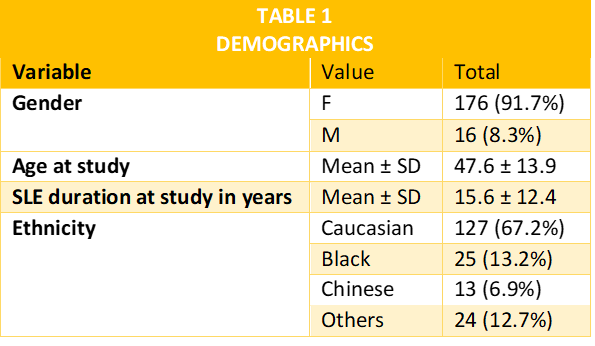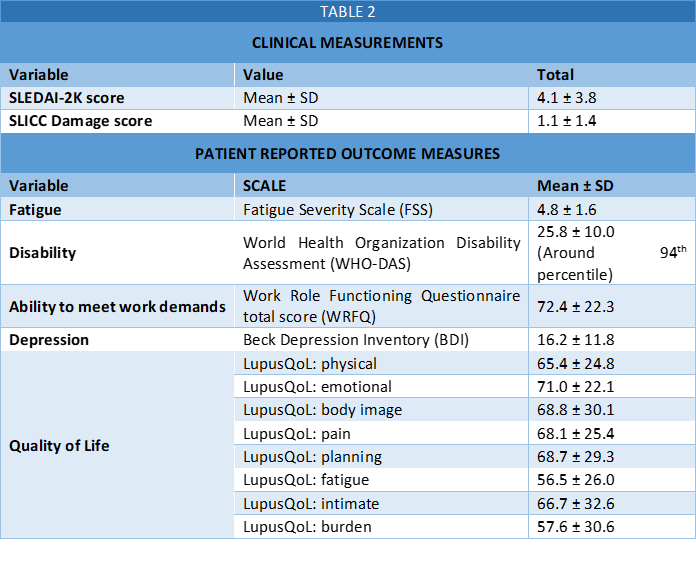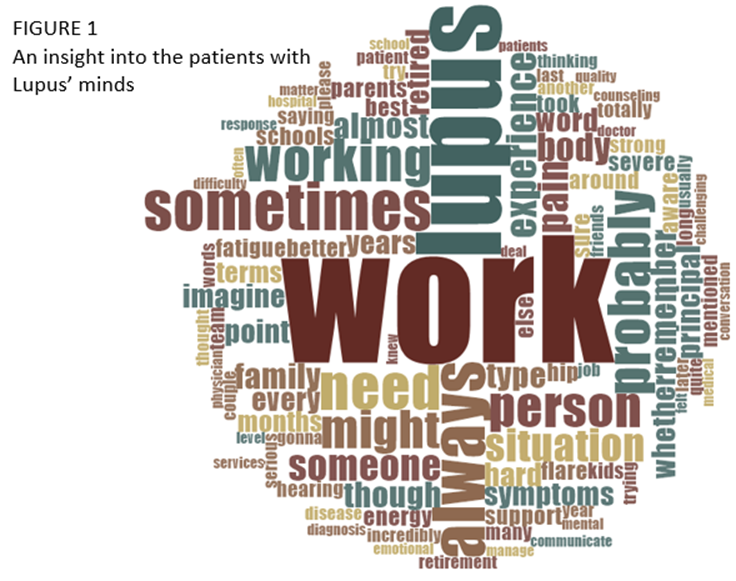Back
Poster Session C
Systemic lupus erythematosus (SLE)
Session: (1440–1485) SLE – Diagnosis, Manifestations, and Outcomes Poster II: Manifestations
1470: Work Disability and Function in Systematic Lupus Erythematosus (SLE): Results from a Mixed-Methods Exploratory Canadian Study
Sunday, November 13, 2022
1:00 PM – 3:00 PM Eastern Time
Location: Virtual Poster Hall
- BN
Behdin Nowrouzi-Kia, PhD, OT
University of Toronto
Toronto, ON, Canada
Abstract Poster Presenter(s)
Behdin Nowrouzi-Kia1, J. Antonio Avina-Zubieta2, Mary T Fox3, William Shaw4, Maggie Ho5, Derek Haaland6, Janet Pope7, Paul R Fortin8, Kathleen Bingham9, Nathalie Rozenbojm10, Mark Matsos11, Christine Peschken12, Amanda Steiman13, Earl Silverman14, Jiandong Su15, Jennifer Reynolds16, Catherine Ivory17, Dafna Gladman18, Murray Urowitz19, Francisco Sanchez-Guerrero20, Lily Lim12, Stephanie Keeling21, Ana Soberanis1, Patricia Katz22 and Zahi Touma15, 1University of Toronto, Toronto, ON, Canada, 2Arthritis Research Canada, University of British Columbia, Vancouver, BC, Canada, 3York University, Toronto, ON, Canada, 4University of Connecticut School of Medicine, Framington, CT, 5University Health Network, Toronto Western Hospital, Toronto, ON, Canada, 6The Waterside Clinic, Oro Medonte, ON, Canada, 7University of Western Ontario, London, ON, Canada, 8Centre ARThrite - CHU de Québec - Université Laval, Québec, QC, Canada, 9Centre for Mental Health, University Health Network; Department of Psychiatry, University of Toronto, Toronto, ON, Canada, 10University Health Network, Toronto, ON, Canada, 11McMaster University, Hamilton, ON, Canada, 12University of Manitoba, Winnipeg, MB, Canada, 13Sinai Health System, Toronto, ON, Canada, 14The Hospital for Sick Children and University of Toronto, Toronto, ON, Canada, 15Schroeder Arthritis Institute, Krembil Research Institute, University Health Network and University of Toronto, Toronto, ON, Canada, 16University of British Columbia Dept of Medicine, Division of Rheumatology, Vancouver, BC, Canada, 17University of Ottawa, Rheumatology, Ottawa, Canada, Ottawa, ON, Canada, 18Toronto Western Hospital, Schroeder Arthritis Institute, Toronto, ON, Canada, 19University of Toronto, University Health Network, Schroeder Arthritis Institute, Toronto, ON, Canada, 20University Health Network/Sinai Health system, Toronto, ON, Canada, 21University of Alberta, Edmonton, AB, Canada, 22UCSF, San Rafael, CA
Background/Purpose: Systemic Lupus Erythematosus (SLE) is a chronic, multisystemic, autoimmune disease which can result in disability and mortality. A functional assessment tool that measures the patient's ability to engage in activities of daily living (ADLs) such as commuting, using technology, or climbing stairs is needed because the inability to carry out these activities translates directly into poor quality of life, leading to poor work performance and absenteeism. The study objective was to describe a functional profile using clinical and patient-reported outcome measures, that identifies the underlying factors of disability and lived-experience in SLE patients.
Methods: A mixed-methods sequential explanatory approach was employed; self-administered questionnaires were used to collect data from patients at 8 Canadian centres (7 academic centres and one community centre), followed by individual interviews. In the first phase, patients who consented were asked to complete the self-administered questionnaires while physicians completed the clinical measures (Table 2). For the second phase, patients were individually interviewed using semi-structured questionnaire to understand their feelings and perspectives on facing the challenges that arise at the workplace due to perceived SLE-related disabilities. The interviews were transcribed verbatim and thematically coded (Figure 1). Summary statistics were computed for demographic, clinical and functional outcomes (Tables 1 and 2).
Results: The sample of 192 patients were mostly female (91.7%), Caucasian (67.2%), with a mean age of 47.6 ± 13.9, and a mean SLE duration of 15.6 ± 12.4 years. (Table 1) The clinical measures showed a SLEDAI-2K score of 4.1 ± 3.8 and an SDI of 1.1 ± 1.4. Patient-Reported Outcome Measures revealed that 22.4% suffered from fibromyalgia, and 32% had depression (defined by BDI score >/= 22); the mean score for the WRFQ was 72.4 ± 22.3, showing that patients experienced important limitations at work; the WHO-DAS 2.0 score of 25.8 is around 94th population percentile, which means only 6.2% of the population score higher (more disabled) than our sample (Table 2).
We identified three preliminary themes including: 1) grit and perseverance in managing their condition (adjusting activities and responsibilities when experiencing flare-ups, changing lifestyle such as diet and exercise) 2) resilient workforce (maintain work activities despite debilitating symptoms, disclosing illness to supervisor, fighting stigma of disease) 3) establishing and maintaining social supports at work (e.g., supportive employers and co-workers, workplace accommodations). The integrated findings provide plausible explanations for high levels of disability experienced.
Conclusion: Our preliminary analyses support the impression that work disability in lupus patients reflect a complex interplay of lupus-related, intrinsic (e.g., comorbidities) and extrinsic (e.g., work environment) factors, for which a functional profile could be of benefit in supporting those at highest risk for poor functional outcomes.
 Table 1. Cohort Characteristics
Table 1. Cohort Characteristics
 Table 2. Clinical Measurements and Patient Reported Outcome Measures
Table 2. Clinical Measurements and Patient Reported Outcome Measures

Disclosures: B. Nowrouzi-Kia, None; J. Avina-Zubieta, None; M. Fox, None; W. Shaw, None; M. Ho, None; D. Haaland, AbbVie, Amgen, AstraZeneca, Bristol-Myers Squibb(BMS), Eli Lilly, GlaxoSmithKlein(GSK), Janssen, Novartis, Pfizer, Roche, Sanofi Genzyme, Takeda, Merck/MSD, UCB, Celgene, Adiga Life-Sciences, Can-Fite Biopharma, Regeneron, Gilead; J. Pope, AbbVie/Abbott, Bristol-Myers Squibb(BMS), Eli Lilly, merk, Roche, Seattle Genetics, UCB, Actelion, Amgen, Bayer, Eicos Sciences, Emerald, Gilead, Janssen, Novartis, Pfizer, Sandoz, Sanofi, Boehringer Ingelheim; P. Fortin, AstraZeneca, GlaxoSmithKlein(GSK); K. Bingham, None; N. Rozenbojm, None; M. Matsos, None; C. Peschken, None; A. Steiman, Pfizer, Jannsen; E. Silverman, None; J. Su, None; J. Reynolds, None; C. Ivory, None; D. Gladman, AbbVie, Amgen, Eli Lilly, Janssen, Gilead, Novartis, Pfizer, Bristol-Myers Squibb(BMS), Galapagos, UCB Pharma, Celgene; M. Urowitz, None; F. Sanchez-Guerrero, None; L. Lim, None; S. Keeling, None; A. Soberanis, None; P. Katz, None; Z. Touma, None.
Background/Purpose: Systemic Lupus Erythematosus (SLE) is a chronic, multisystemic, autoimmune disease which can result in disability and mortality. A functional assessment tool that measures the patient's ability to engage in activities of daily living (ADLs) such as commuting, using technology, or climbing stairs is needed because the inability to carry out these activities translates directly into poor quality of life, leading to poor work performance and absenteeism. The study objective was to describe a functional profile using clinical and patient-reported outcome measures, that identifies the underlying factors of disability and lived-experience in SLE patients.
Methods: A mixed-methods sequential explanatory approach was employed; self-administered questionnaires were used to collect data from patients at 8 Canadian centres (7 academic centres and one community centre), followed by individual interviews. In the first phase, patients who consented were asked to complete the self-administered questionnaires while physicians completed the clinical measures (Table 2). For the second phase, patients were individually interviewed using semi-structured questionnaire to understand their feelings and perspectives on facing the challenges that arise at the workplace due to perceived SLE-related disabilities. The interviews were transcribed verbatim and thematically coded (Figure 1). Summary statistics were computed for demographic, clinical and functional outcomes (Tables 1 and 2).
Results: The sample of 192 patients were mostly female (91.7%), Caucasian (67.2%), with a mean age of 47.6 ± 13.9, and a mean SLE duration of 15.6 ± 12.4 years. (Table 1) The clinical measures showed a SLEDAI-2K score of 4.1 ± 3.8 and an SDI of 1.1 ± 1.4. Patient-Reported Outcome Measures revealed that 22.4% suffered from fibromyalgia, and 32% had depression (defined by BDI score >/= 22); the mean score for the WRFQ was 72.4 ± 22.3, showing that patients experienced important limitations at work; the WHO-DAS 2.0 score of 25.8 is around 94th population percentile, which means only 6.2% of the population score higher (more disabled) than our sample (Table 2).
We identified three preliminary themes including: 1) grit and perseverance in managing their condition (adjusting activities and responsibilities when experiencing flare-ups, changing lifestyle such as diet and exercise) 2) resilient workforce (maintain work activities despite debilitating symptoms, disclosing illness to supervisor, fighting stigma of disease) 3) establishing and maintaining social supports at work (e.g., supportive employers and co-workers, workplace accommodations). The integrated findings provide plausible explanations for high levels of disability experienced.
Conclusion: Our preliminary analyses support the impression that work disability in lupus patients reflect a complex interplay of lupus-related, intrinsic (e.g., comorbidities) and extrinsic (e.g., work environment) factors, for which a functional profile could be of benefit in supporting those at highest risk for poor functional outcomes.
 Table 1. Cohort Characteristics
Table 1. Cohort Characteristics Table 2. Clinical Measurements and Patient Reported Outcome Measures
Table 2. Clinical Measurements and Patient Reported Outcome Measures
Disclosures: B. Nowrouzi-Kia, None; J. Avina-Zubieta, None; M. Fox, None; W. Shaw, None; M. Ho, None; D. Haaland, AbbVie, Amgen, AstraZeneca, Bristol-Myers Squibb(BMS), Eli Lilly, GlaxoSmithKlein(GSK), Janssen, Novartis, Pfizer, Roche, Sanofi Genzyme, Takeda, Merck/MSD, UCB, Celgene, Adiga Life-Sciences, Can-Fite Biopharma, Regeneron, Gilead; J. Pope, AbbVie/Abbott, Bristol-Myers Squibb(BMS), Eli Lilly, merk, Roche, Seattle Genetics, UCB, Actelion, Amgen, Bayer, Eicos Sciences, Emerald, Gilead, Janssen, Novartis, Pfizer, Sandoz, Sanofi, Boehringer Ingelheim; P. Fortin, AstraZeneca, GlaxoSmithKlein(GSK); K. Bingham, None; N. Rozenbojm, None; M. Matsos, None; C. Peschken, None; A. Steiman, Pfizer, Jannsen; E. Silverman, None; J. Su, None; J. Reynolds, None; C. Ivory, None; D. Gladman, AbbVie, Amgen, Eli Lilly, Janssen, Gilead, Novartis, Pfizer, Bristol-Myers Squibb(BMS), Galapagos, UCB Pharma, Celgene; M. Urowitz, None; F. Sanchez-Guerrero, None; L. Lim, None; S. Keeling, None; A. Soberanis, None; P. Katz, None; Z. Touma, None.

